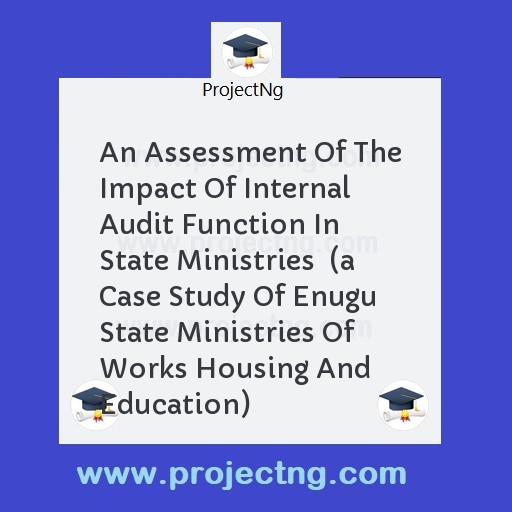An Assessment Of The Impact Of Internal Audit Function In State Ministries (a Case Study Of Enugu State Ministries Of Works Housing And Education)
Accounting Project Topics
Get the Complete Project Materials Now! »
AN ASSESSMENT OF THE IMPACT OF INTERNAL AUDIT FUNCTION IN STATE MINISTRIES
(A CASE STUDY OF ENUGU STATE MINISTRIES OF WORKS HOUSING AND EDUCATION)
ABATRACT
The aim of this research is to asses and evaluate the impact of internal Auditing in ministries and to ascertain the extent to which government finance and properties are accounted for.
The research will be tested in different hypothesis, where the Null hypothesis will be rejected and the alternative hypothesis will be accepted. The method of data collection will be both primary and secondary.
In the course of this research the researcher will encounter some constraints such as financial constraint inadequate material and initial resistance to release information by the staff of the ministries.
This project will be helpful in solving practical problem associated with auditing especially to students and any other person with little or no practical auditing experience.
In addition some recommendation will be made which if implemented will enhance the advancement of internal auditing organizations.
TABLE OF CONTENT
Title page I
Certification ii
Dedication iii
Acknowledgement iv
Abstract v
CHAPTER ONE
1.1 Introduction 1-6
1.2 Statement of problem 6-7
1.3 Objective of study 7-8
1.4 Scope and limitation of study 8-9
1.5 Relevance of study 9-10
References 10-11
CHAPTER TWO
2.1 Historical background of internal audit in government 12-16
2.2 Objective and audit 16-17
2.3 Advantage of internal Audit 17-18
2.4 Internal control and check 18-19
2.5 Qualities of an Auditoe 19-20
2.6 The role of internal audit 20-23
2.7 Qualities control of internal Audit 23-38
REFERENCE
CHAPTER THREE
RESEARCH METHODOLOGY 40
3.1 Research design 40
3.2 Sample selection 40
3.3 Sampling technique 41
3.4 Source of data 41-42
3.5 Questionnaire design 42
3.6 data treatment and method of analysis 42
REFERENCE
CHAPTER FOUR
DATA PRESENTATION AND ANALYSIS
4.1 introduction 43
4.2 Presentation of data from research questionnaire 43-39
4.3 Test any prove of hypothesis 60-64
CHAPTER FIVE
FINDNGS CONCLUSION AND RECOMMENDATION
5.1 Summary of findings 65-66
5.2 Conclusion 66-68
5.3 Recommendation 68-70
5.4 Suggestions for further studies 70-71
Bibliography 72-73
Appendix 74-80
CHAPTER ONE
1.1 INTRODUCTION
As government has grown in scope size and complexity so too the need for internal auditing accounting for and controlling government receipts and expenditure has resulted in the need for a staggering number of government clerks, accountants and auditors.
The need for control over government revenue appropriation and expenditure should not be surprising federal, state and local government is actually the largest industry in the country. However the need for efficient and effective internal auditing system in government ministries and extra- ministerial department can not be over emphasized as the complexity of government activities is obvious . the annual budgets by federal state and local government are generally incorporated into governmental accounting system and financial reports, this is not the case in private sector business organization. Thus the annual budgets in conjunction with government financial reports are the primary focus of public sector audits. Internal auditing is an independent appraisal function established within an organization to examine and organization Taylor and Glezen (1979) it is mainly concerned with appraised of government activities for the review of accounting financial and operations as a service to the management
INTERNAL EXTERNAL AUDITOR
A person who undertakes audit function is called an auditor. Internal audit has been described as an independent review of operation and records. Sometime continuous undertake within an organization by especially assigned staff of the organization as basis for long protection and constructive services to management Ubesis (1997).
External auditor is an independent examination of financial statement of an organization an auditor. Other than an employee of an organization but by appointment by the share holders, like external audit, internal auditing had its role in accent time infect internal and external audit had essentially the same beginning there was no distinction between them prior to the nineteenth century “Ricchute (1975). Both group of auditor rely on the same data base. Also the internal user rely on both internal and external auditors and external user rely on external auditors. Importantly, external auditors can sometime rely upon an internal auditors work when the internal audit function is strong. As a
Be the First to Share On Social

Enjoying our content?
Don't miss out on new videos! Subscribe to our YouTube channel for more awesome content.
Subscribe Now!













